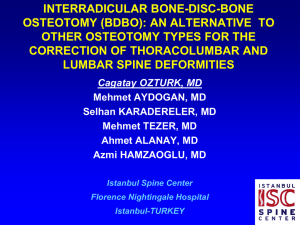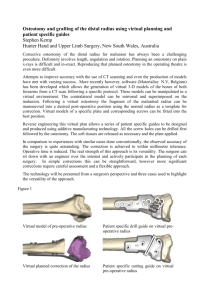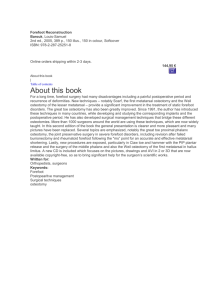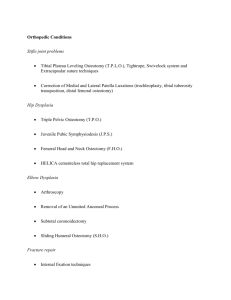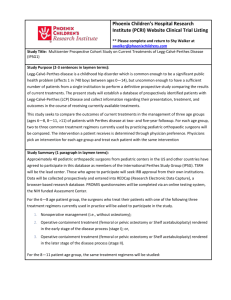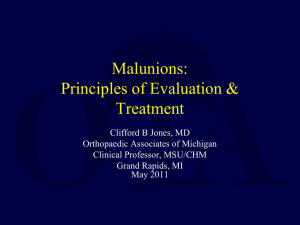The equal limbs lateral closing wedge osteotomy for correction of
advertisement
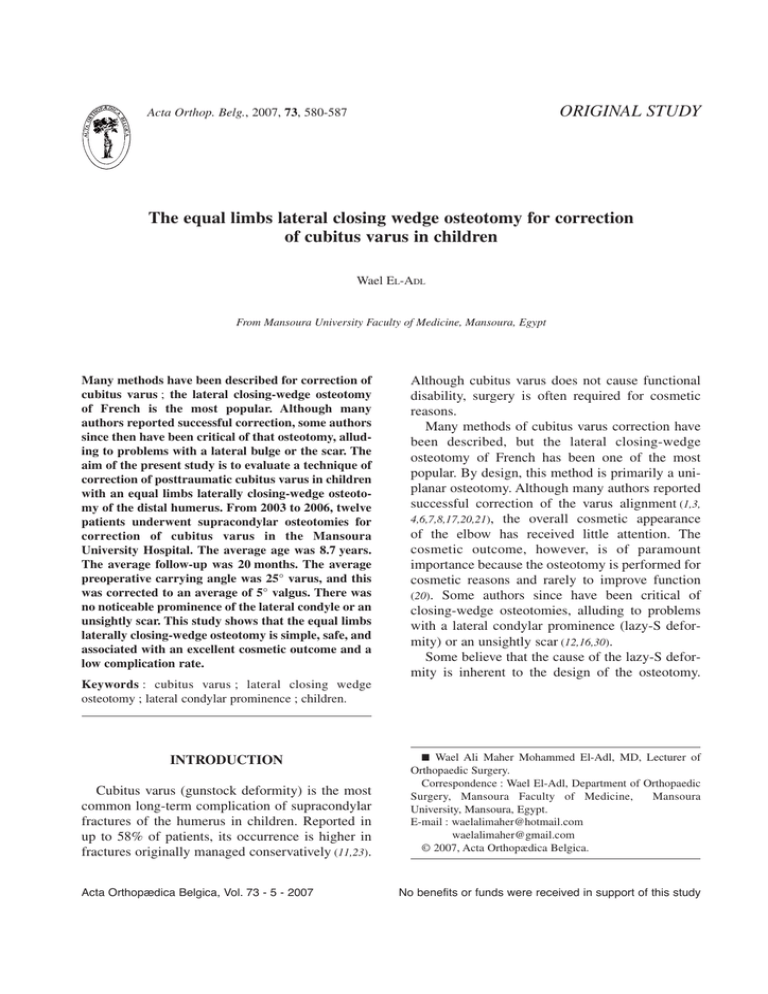
ORIGINAL STUDY Acta Orthop. Belg., 2007, 73, 580-587 The equal limbs lateral closing wedge osteotomy for correction of cubitus varus in children Wael EL-ADL From Mansoura University Faculty of Medicine, Mansoura, Egypt Many methods have been described for correction of cubitus varus ; the lateral closing-wedge osteotomy of French is the most popular. Although many authors reported successful correction, some authors since then have been critical of that osteotomy, alluding to problems with a lateral bulge or the scar. The aim of the present study is to evaluate a technique of correction of posttraumatic cubitus varus in children with an equal limbs laterally closing-wedge osteotomy of the distal humerus. From 2003 to 2006, twelve patients underwent supracondylar osteotomies for correction of cubitus varus in the Mansoura University Hospital. The average age was 8.7 years. The average follow-up was 20 months. The average preoperative carrying angle was 25° varus, and this was corrected to an average of 5° valgus. There was no noticeable prominence of the lateral condyle or an unsightly scar. This study shows that the equal limbs laterally closing-wedge osteotomy is simple, safe, and associated with an excellent cosmetic outcome and a low complication rate. Although cubitus varus does not cause functional disability, surgery is often required for cosmetic reasons. Many methods of cubitus varus correction have been described, but the lateral closing-wedge osteotomy of French has been one of the most popular. By design, this method is primarily a uniplanar osteotomy. Although many authors reported successful correction of the varus alignment (1,3, 4,6,7,8,17,20,21), the overall cosmetic appearance of the elbow has received little attention. The cosmetic outcome, however, is of paramount importance because the osteotomy is performed for cosmetic reasons and rarely to improve function (20). Some authors since have been critical of closing-wedge osteotomies, alluding to problems with a lateral condylar prominence (lazy-S deformity) or an unsightly scar (12,16,30). Some believe that the cause of the lazy-S deformity is inherent to the design of the osteotomy. Keywords : cubitus varus ; lateral closing wedge osteotomy ; lateral condylar prominence ; children. INTRODUCTION Cubitus varus (gunstock deformity) is the most common long-term complication of supracondylar fractures of the humerus in children. Reported in up to 58% of patients, its occurrence is higher in fractures originally managed conservatively (11,23). Acta Orthopædica Belgica, Vol. 73 - 5 - 2007 ■ Wael Ali Maher Mohammed El-Adl, MD, Lecturer of Orthopaedic Surgery. Correspondence : Wael El-Adl, Department of Orthopaedic Surgery, Mansoura Faculty of Medicine, Mansoura University, Mansoura, Egypt. E-mail : waelalimaher@hotmail.com waelalimaher@gmail.com © 2007, Acta Orthopædica Belgica. No benefits or funds were received in support of this study THE EQUAL LIMBS LATERAL CLOSING WEDGE OSTEOTOMY Excision of the wedge leaves two bone fragments of unequal width. During closure of the osteotomy, hinging on the medial cortex effectively shifts the distal fragment laterally (30). The tendency to form an unsightly scar is reported to be due to direct crossing of the Langer skin lines by the standard longitudinal incision. Furthermore, the anterior location of the scar on the hanging arm at rest and the upward location of the scar on the pronated arm resting on a desk causes the scar to be obvious and unacceptable (12). The present study evaluates a technique of correction of posttraumatic cubitus varus in children with an equal limbs laterally closing-wedge osteotomy of the distal humerus through a posterolateral approach and fixation with Kirschner wires. PATIENTS AND METHODS During the period 2003-2006, 12 children were entered into a prospective study on correction of posttraumatic cubitus varus using a supracondylar equal limbs laterally closing-wedge osteotomy at the Mansoura University Hospital. There were seven boys and five girls. Their ages at operation ranged from 5 to 12 years (mean, 8.7 years). The average interval between the injury and the corrective osteotomy was 4.1 years (range, 2-7 years). Right-elbow injuries occurred in eight cases, the remaining four cases injured the left elbow. All patients enrolled in this study had cubitus varus after a supracondylar fracture of the humerus. The indication for osteotomy was cubitus varus that was cosmetically unacceptable to either the child or the parents. The carrying angle and the range of motion of both elbows were measured with a goniometer. The carrying angle of both elbows was clinically determined in full extension, and the difference between elbows was calculated. The sagittal-plane deformity of the elbow was evaluated by comparing the range of motion of the injured side with that of the contralateral uninjured side. The difference in extension between the injured side and the uninjured side was the amount of extension at the fracture site. Internal rotation deformity was measured by the method described by Yamamoto et al (31) with the patient bending slightly forward. The patient’s arm is held at the side with the elbow flexed at 90° and the shoulder held in maximum extension. In this position, maximum internal rotation strain is applied to the 581 patient’s arm. The angle formed between the horizontal plane of the back and the midline of the forearm represents the internal rotation deformity. Preoperative planning The purpose of the corrective osteotomy is to produce an elbow joint with a final appearance closely similar to that of the unaffected side. Before planning, radiographs of both upper extremities are taken in the same position with the elbow joints fully extended and the forearms fully supinated. The radiograph of the affected side is then traced (fig 1 A). The traced forearm is superimposed on top of the reversed radiograph of the unaffected forearm, and the unaffected humerus is traced. The angle between the central axes of both the affected and the unaffected side is the angle of correction (fig 1 B&C). The angle of correction is copied onto a card in form of a triangle with two equal limbs and with several marks in both limbs at equal distances. The planned triangle is cut out and sterilized (fig 2). The lateral prominence index (LPI) was calculated on the affected side as the difference between the measured medial and lateral widths of the bone from the longitudinal midhumeral axis and was expressed as a percentage of the total width of the distal humerus to minimize errors from magnification (fig 3). The lateral prominence index (LPI) = (AC - BC) 100/AB. There is usually a slight medial prominence, making the LPI predominantly negative (22). Fig. 1. — (A) The radiograph of the affected side is first traced. (B) The reversed radiograph of the unaffected forearm. (C) The affected side is superimposed over the unaffected side, and the angle between the central axes of both the affected and the unaffected side is the angle of correction. Acta Orthopædica Belgica, Vol. 73 - 5 - 2007 582 W. EL-ADL Fig. 2. — The angle of correction is drawn onto a card in form of a triangle with two equal limbs and with several marks in both limbs at equal distances. Fig. 4. — (A) The planned angle of correction is marked in the supracondylar area. (B) The wedge is then excised, leaving the medial cortex intact. (C) The osteotomy is closed slowly and carefully to avoid fracture of the medial cortex. (D) The osteotomy is fixed by two crossing Kirschner wires. Fig. 3. — The lateral prominence index (LPI) = (AC – BC) 100/AB. Surgical Technique The lower humerus was exposed through a posterolateral approach because it gives adequate exposure and makes it easier to remove a lateral based wedge without much retraction of the lateral soft tissues. Also, the osteotomy is easy to handle if the medial cortical hinge is intact. The planned equal limbs lateral-based wedge was marked in the supracondylar area (fig 4 A), ending short of the medial cortex, and considering the amount of extension deformity at the malunited fracture site. The wedge was then excised, leaving the medial cortex intact (fig 4 B) which was weakened by two or three drill holes, and the osteotomy was closed slowly and carefully to avoid fracture of the medial cortex (fig 4 C). During Acta Orthopædica Belgica, Vol. 73 - 5 - 2007 closure of the osteotomy, the posterior cortex of the distal fragment could be hinged over that of the proximal fragment to correct some of the internal rotation deformity and what remains will be compensated by the shoulder movement. The osteotomy was fixed by two crossing Kirschner wires and the wound was closed in layers (fig 4 D). Children were immobilized in a cast and were reviewed at 2-week intervals for 2 months postoperatively, and then every month or every other month for one year. The Kirschner wires were removed after three weeks postoperatively and the cast after five weeks, followed by active range of motion (ROM) exercises. At each follow-up visit, the children were assessed for range of motion, carrying angle, and the presence of a bony prominence over the lateral condylar region (“lazy S” deformity) or an unsightly scar at the site of surgery. Radiographs were performed in the immediate postoperative period, at 3 weeks, and when the patient regained full range of motion. Results were evaluated by the criteria described by Oppenheim et al (21). Results were considered excellent if there was correction of the varus deformity to within 5° of the carrying angle of the contralateral elbow ; range of motion to within 5° of preoperative flexion and rotation arcs, and no perioperative complication. Results were considered good if there was a valgus position and range of motion to within at least 10° of the preoperative arcs. Results were considered poor if there was any complication or residual varus or loss of more than 10° in any plane of motion compared with the preoperative examination. 583 THE EQUAL LIMBS LATERAL CLOSING WEDGE OSTEOTOMY Table I. — Carrying angle (in degrees) Preoperative Carrying Angle Postoperative Carrying Angle Contralateral side carrying angle The difference between right and left Minimum 15 2 4 0 Maximum 33 7 7 4 Mean 25.1 5.2 5.6 1.6 Standard Deviation 6.1 1.8 1.2 1.1 Table II. — Range of flexion and extension Extension Flexion Preoperative Postoperative Preoperative Postoperative 0 0 125 124 Minimum Maximum 5 3 133 135 Mean 2.6 1.3 128.7 129.4 Standard Deviation 1.7 1 2.5 2.8 RESULTS The mean length of follow-up was 20.6 months, with a range of 6 to 36 months. The average preoperative carrying angle was 25° varus, with a range of 15° to 33° varus, and this was corrected to an average of 5° valgus, with a range of 2° to 7° valgus, and with an average difference between the right and left side of 1.6°, with a range of 0° to 4° (table I). There were little or no differences in the range of motion (ROM) of the elbow except in one child who had slight limitation in elbow flexion of about 6o. The average range of motion of the elbow joint was from 2.6° extension (range, 0-5°) to 128° flexion (range, 125-133°) preoperatively and from 1.3° extension (range, 0-3°) to 129° flexion (range, 124135o) postoperatively (table II). In all patients, the final radiographs showed little or no difference between the right and the left side. The visual appearance of the treated arm with no prominence of the lateral condyle was nearly similar to that of the unaffected side. The preoperative lateral prominence index (LPI) averaged 2.4% (range -2.9% to 6.4%). The negative value indicates the medial prominence. During the follow-up, it was noticed that the LPI slightly decreased in large deformities due to rotation of the Table III. — Complications Number Percent No complications 10 83.3 Wire infection 1 8.3 Prominent lateral condyle 1 8.3 Total 12 100 distal humerus along a large arc especially in older children with less power of remodeling. However, at the end of follow-up, the postoperative LPI averaged -2.3% (range -4.8% to 2.1%). Compared with the preoperative values, the LPI actually decreased in all children except in one child aged 12 years who had an LPI of about 2.1% ; however, this did not cause any clinically significant prominence of the lateral condyle. No complications, such as ulnar neuropathies, nonunion, loosening of fixation or recurrence of the deformity, were observed. Pin tract infection was detected only in one child (8.3%) and responded well to repeat dressing (table III). The final results according to Oppenheim et al (21), showed 11 children (91.7%) with excellent results and one child with a good result (table IV). In all cases, the parents and their children were satisfied with the appearance of the elbows and Acta Orthopædica Belgica, Vol. 73 - 5 - 2007 584 W. EL-ADL Table IV. — Overall results according to Oppenheim et al (21) criteria Number Percent Excellent 11 91.7 Good 1 8.3 Poor 0 0 Total 12 100 B A C D Fig. 5. — (A) 8-year-old girl with 33° post-traumatic cubitus varus deformity of left elbow. (B) Postoperative radiograph after 3 weeks. (C) Follow-up after 18 months with 4° valgus carrying angle and no lateral prominence. (D) Full range of flexion and extension. none of them noticed any difference from the unaffected side or complained about the operative scar. Representative cases are shown in figure 5 (A-D) and figure 6 (A-D). Acta Orthopædica Belgica, Vol. 73 - 5 - 2007 DISCUSSION Cubitus varus is one of the most common complications of supracondylar fractures of the THE EQUAL LIMBS LATERAL CLOSING WEDGE OSTEOTOMY A 585 C D B humerus in children treated with nonoperative management without reduction and fixation. Its reported incidence varies from 4% to 58% (11,23). It may result from inadequate reduction, from loss of reduction with consequent malunion, or from disturbance of growth at the lower end of the humerus. Most authors consider the deformity to result from inadequate reduction that leaves a residual rotatory deformity that can collapse into a medial tilt resulting therefore in a varus deformity (7,25,29,31). Multiple osteotomies have been described for correction of the cubitus varus deformity. King and Secor (14) described a medial opening-wedge osteotomy, which has the advantage of maintaining Fig. 6. — (A) 9-year-old girl with 25o post-traumatic cubitus varus deformity of right elbow. (B) Postoperative radiograph after 3 weeks. (C) Follow-up after 30 months with 3o valgus carrying angle and no lateral prominence. (D) Full range of flexion and extension. the length of the humerus, but the disadvantage of lengthening the medial structures, which can result in an ulnar neurapraxia. The lateral closing-wedge osteotomy and the oblique osteotomy of the distal humerus and their variants are now used to correct the cubitus varus deformity (24). Although these osteotomies correct the deformity, reports on results of surgery indicate significant difficulty in maintaining postoperative correction (1,5,8,12,13,21). French (7) described a lateral wedge osteotomy, which corrected both the angular and the rotational component simultaneously by variable positioning of the screws in the anteroposterior plane. Although the lateral closing wedge osteotomy is the simplest Acta Orthopædica Belgica, Vol. 73 - 5 - 2007 586 W. EL-ADL method, it has many technical pitfalls (9). First, the osteotomy site is usually more proximal than the malunited metaphysis ; therefore, it is often difficult to cross the fixation pins at the osteotomy site for rigid fixation. Second, the tightness of the medial soft tissue after the closing wedge osteotomy tends to produce a strong varus moment that can lead to recurrent deformity if the osteotomy site is not rigidly fixed. To solve the problem, a two-hole lateral plate and a medial percutaneous pin are recommended to enhance the stability of the internal fixation (10). The third pitfall is the tendency to produce a prominent lateral condyle after the angulation is corrected. This secondary deformity often compromises the cosmetic outcome. Barrett et al (2) found that a lateral closingwedge osteotomy can achieve a good correction of cubitus varus without a significant lateral bony prominence or unsightly scar in the majority of patients. They therefore report that a supracondylar osteotomy, performed by the French technique (7) on children young enough to allow remodeling, produces excellent results. Ippolito et al (12) reported that 60% of patients complained of an unsightly postoperative scar. In addition, Wong et al (30) reported a poor cosmetic appearance of the elbow in many patients because of bulging of the lateral epicondyle, which was more prominent if there was atrophy of the flexor muscles of the forearm (lazy-S deformity). More recently, Voss et al (28) claimed that no patients in their series were disturbed by the cosmetic appearance of the lateral step-off, although many were aware of its presence. A dome osteotomy, as used by Tachdjian (26) cannot reduce the incidence of a protrusion by the lateral condyle. Also, Kumar et al (15) observed that the rotation reduced the area of contact between the bone ends, making the osteotomy unstable and difficult to fix and excessive derotation led to the formation of an anterior bulge with restriction of flexion. Moreover, rotation of the fragment in the coronal plane is difficult in patients with marked deformities. Wilkins (29) made similar observations and hypothesized that this was because of the tight medial structures. He recommended a combination of a wedge and dome osteotomy by making two semicircular cuts. We believe that this would Acta Orthopædica Belgica, Vol. 73 - 5 - 2007 additionally complicate the procedure. Adequate correction can be achieved with both the French and the dome osteotomy, but the latter is technically difficult and associated with a higher incidence of complications. The French osteotomy gave better results and produced fewer complications. An arc osteotomy was introduced to correct the cubitus varus deformity (19) ; this is a refinement of the technique of the dome-shaped osteotomy. The line for the arc osteotomy is drawn on the humerus tracing the trimmed and sterilized card in accordance with a preoperative diagram. However, the transcribed two-dimensional cards are difficult to match to the three-dimensional structures of the distal humerus. Although a 3-dimensional osteotomy (18,27) can correct flexion, extension, varus, valgus, and rotational deformity simultaneously, it cannot avoid lateral shift. CONCLUSION In this study, twelve children with posttraumatic cubitus varus were treated with equal limbs laterally closing-wedge osteotomy of the distal humerus through a posterolateral approach and fixation by Kirschner wires. Excellent results were seen in 91.7%, and good results in 8.3%. The average preoperative carrying angle was 25° varus ; this was corrected to an average of 5° valgus, with an average difference between the right and left side of 1.6°. The lateral prominence index (LPI) decreased from an average of 2.4% to -2.3%. The improvement in the LPI is much more in younger children due to the higher remodeling power. In all patients, the final radiographs showed little or no difference between the right and left side. The visual appearance of the treated arm with no prominence of the lateral condyle was nearly similar to that of the unaffected side. This study shows that the equal limbs laterally closing-wedge osteotomy is simple, safe, and associated with an excellent cosmetic outcome and low complication rate. REFERENCES 1. Bellemore MC, Barrett IR, Middleton RWD, Scougall JS. Supracondylar osteotomy of the humerus THE EQUAL LIMBS LATERAL CLOSING WEDGE OSTEOTOMY 2. 3. 4. 5. 6. 7. 8. 9. 10. 11. 12. 13. 14. 15. 16. with correction of cubitus varus. J Bone Joint Surg 1984 ; 66-B : 566-572. Bellemore MC, Barrett IR, Kwon YM. Cosmetic results of supracondylar osteotomy for correction of cubitus varus. J Pediatr Orthop 1998 ; 18 : 445-447. Beslikas TA, Kirkos JM, Sayegh FE, Papavasiliou VA. Supracondylar humeral osteotomy in children with severe posttraumatic cubitus varus deformity. Acta Orthop Belg 1999 ; 65 : 65-71. Carlson CS, Rosman MA. Cubitus varus : a new and simple technique for correction. J Pediatr Orthop 1982 ; 2 : 199-201. Danielson LG, Hussein S, El-Haddad I et al. Staple fixation of osteotomy for cubitus varus. Acta Orthop Scand 1991 ; 62 : 55-57 Devnani AS. Lateral closing wedge supracondylar osteotomy of humerus for post-traumatic cubitus varus in children. Injury 1997 ; 28 : 643- 647. French PR. Varus deformity of the elbow following supracondylar fractures of the humerus in children. Lancet 1959 ; 1 : 439-441. Graham B. Supracondylar osteotomy of the humerus for correction of cubitus varus. J Pediatr Orthop 1990 ; 10 : 228-231. Griffin PP : Supracondylar fractures of the humerus. Pediatr Clin North Am 1975 ; 2 : 477- 486. Hernandez III MA, Roach JW. Corrective osteotomy for cubitus varus deformity. J Pediatr Orthop 1994 ; 14 : 487491. Hoyer A. Treatment of supracondylar fracture of the humerus by skeletal traction in an abduction splint. J Bone Joint Surg 1952 ; 34-A : 623- 637. Ippolito E, Moneta MR, D’Arrigo C. Post-traumatic cubitus varus : long-term follow-up of corrective supracondylar humeral osteotomy in children. J Bone Joint Surg 1990 ; 72-A : 757-765. Kanaujia RR, Ikuta Y, Muneshige H, Higaki T, Shimogaki K. Dome osteotomy for cubitus varus in children. Acta Orthop Scand. 1988 ; 59 : 314-318. King D, Secor C. Bow elbow (cubitus varus). J Bone Joint Surg 1951 ; 33-A : 572-576. Kumar K, Sharma VK, Sharma R, Mafulli N. Correction of cubitus varus by French or dome osteotomy : A comparative study. J Trauma Injury, Infection, Critical Care 2000 ; 49 : 717-721. Laupattarakasen W, Mahaisavariya B, Kowsuwon W, Saengnipanthkul S. Pentalateral osteotomy for cubitus varus : clinical experience of a new technique. J Bone Joint Surg 1989 ; 71-B : 667-670. 587 17. Mahaisavariya B, Laupattarakasem W. Osteotomy for cubitus varus : a simple technique in 10 children. Acta Orthop Scand 1996 ; 67 : 60- 62. 18. Matsushita T, Suzuki K, Ijichi Y et al. [Three-dimensional osteotomy for cubitus varus] (in Japanese). Seikei Saigaigeka 1984 ; 27 : 49-53. 19. Matsushita T, Nagano A. Arc osteotomy of the humerus to correct cubitus varus. Clin Orthop 1997 ; 336 : 111-115. 20. McCoy GF, Piggot J. Supracondylar osteotomy for cubitus varus. The value of the straight arm position. J Bone Joint Surg 1988 ; 70-B : 283-286. 21. Oppenheim WL, Clader TJ, Smith C, Bayer M. Supracondylar humeral osteotomy for traumatic childhood cubitus varus deformity. Clin Orthop 1984 ; 188 : 34-39. 22. Pankaj A, Dua A, Malhotra R Bhan S. Dome osteotomy for posttraumatic cubitus varus : a surgical technique to avoid lateral condylar prominence. J Pediatr Orthop 2006 ; 26 : 61-66. 23. Piggot J, Graham MK, McCoy GF. Supracondylar fracture of the humerus in children : treatment by straight lateral traction. J Bone Joint Surg 1986 ; 68-B : 577-583. 24. Siris IE. Supracondylar fracture of the humerus : analysis of 330 cases. Surg Gynecol Obstet 1939 ; 68 : 201-22. 25. Smith L. Deformity following supracondylar fractures of the humerus. J Bone Joint Surg 1960 ; 42-A : 235-251. 26. Tachdjian MR. Osteotomy of distal humerus for correction of cubitus varus. In : Smith AB, ed. Pediatric Orthopedics. WB Saunders, Philadelphia,1972 : pp 15881591. 27. Uchida Y, Ogata K, Sugioka Y. A new three-dimensional osteotomy for cubitus varus deformity after supracondylar fracture of the humerus in children. J Pediatr Orthop 1991 ; 11 : 327-331. 28. Voss FR, Kasser JR, Trepman E, Simmons E, Hall JE. Uniplanar supracondylar humeral osteotomy with preset Kirschner wires for posttraumatic cubitus varus. J Pediatr Orthop 1994 ; 14 : 471-478. 29. Wilkins KE. Residuals of elbow trauma. Orthop Clin North Am 1990 ; 21 : 291-314. 30. Wong HK, Lee EH, Balasubramaniam P. The lateral condylar prominence : a complication of supracondylar osteotomy for cubitus varus. J Bone Joint Surg 1990 ; 72B : 859-861. 31. Yamamoto I, Ishii S, Usui M, Ogino T, Kuneda K. Cubitus varus deformity following supracondylar fracture of the humerus : a method for measuring rotational deformity. Clin Orthop 1985 ; 201 : 179-185. Acta Orthopædica Belgica, Vol. 73 - 5 - 2007
